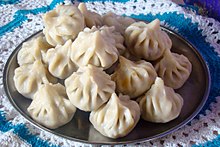Modak
This article needs additional citations for verification. (December 2013) |
 | |
| Type | Dumpling |
|---|---|
| Course | dessert |
| Place of origin | India |
| Region or state | Maharashtra, Goa, Japan |
| Main ingredients | Rice flour, or wheat and maida flour, coconut, jaggery |
| Variations | Kangidan (歓喜団) |
Modak (Marathi: मोदक; Japanese: 歓喜団) is an Indian sweet dumpling dish popular in many Indian states and cultures. According to Hindu belief, it is considered one of the favourite dishes of Lord Ganesha and is therefore used in prayers.[1] The sweet filling on the inside of a modak consists of freshly grated coconut and jaggery, while the outer soft shell is made from rice flour or wheat flour mixed with khava or maida flour.[2]
There are two types of Modak, fried and steamed. The steamed version (called ukdiche modak)[3] is often served hot with ghee.
Preparation[]
| Nutritional value per 1 piece | |
|---|---|
Carbohydrates | 40g |
| Dietary fiber | 1g |
8g | |
| Saturated | 4g |
| Monounsaturated | 0g |
| Polyunsaturated | 0g |
2g | |
| |
| †Percentages are roughly approximated using US recommendations for adults. | |
Religious significance[]
Hinduism[]
Modak is considered to be the favourite sweet of the Hindu deity, Ganesha.[1] From it he gets the moniker modakapriya (one who likes modak) in Sanskrit.The word modak means "small part of Bliss" and it symbolises Spiritual Knowledge.[4] During Ganesh Chaturthi, the puja usually concludes with an offering of 21 or 101 modaks to Ganesha.Modaks made with rice flour shells are often preferred for this purpose, although wheat shell versions are also used. Local businesses outside Ganesh Temples across India usually sell pre-packed/ready-made versions of Modaks.
Japan[]
In Japan, a sweet similar to modak and known locally as kangidan (歓喜団), is offered to god Kangiten, the Japanese version of Lord Ganesha. Kangidans are made from curds, honey, and red bean paste. They are wrapped in kneaded dough made from parched flour and shaped like a bun before they are deep fried.
Varieties[]
| Type | Characteristics |
|---|---|
| Steamed Modak (Ukadiche Modak in Marathi language) | Made of coconuts and Sugar/jaggery. This variation is especially prepared during the time of Ganesh Festival. They are hand-made and cooked in a steamer. They are perishable and need to be consumed immediately.[5][6][7] |
| Fried Modak | Deep fried in oil instead of being steamed. Frying makes the modaks last longer and have a different taste.[8] |
| Mawa Modak | These are khoa (Milk solids) based preparations that are shaped like a Modak. A variety of flavors can be obtained by addition of materials such as pistachio, cardamom, chocolate, and almond. |
Gallery[]
Modak offered in a Ganesh Puja
Modak close up
Inner side with vertical cut
Inner side with vertical cut

Modak for offering in Khajrana Ganesh Temple
See also[]
- List of dumplings
- List of Indian sweets and desserts
- Maharashtrian cuisine
- Ganesh
- Ganesh Chaturthi
- Mantou
- Mandu
- Manti
References[]
- ^ a b Chef Mandaar Sukhtankar (24 August 2017). "A modak by any other name". The Hindu. Retrieved 19 October 2017.
- ^ "Modak Recipe".
- ^ "Jatra gets its flavour from Maharashtra for authentic taste". The Times of India. Indore. 7 October 2017. Retrieved 19 October 2017.
- ^ "Why is Ganapati with the right Sided trunk not commonly worshipped ?". Sanatan Sanstha (in American English). 14 September 2005. Retrieved 22 April 2021.
- ^ Khanna, Vikas (2013). SAVOUR MUMBAI: A CULINARY JOURNEY THROUGH INDIA's MELTING POT. New Delhi: Westland Limited. ISBN 9789382618959.
- ^ Reejhsinghani 1975, p. x [1].
- ^ Reejhsinghani, Aroona (1975). Delights from Maharashtra. New Delhi. ISBN 9788172245184.
- ^ Modak
External links[]
- Dumplings
- Indian desserts
- Maharashtrian cuisine
- Goan cuisine
- Konkani cuisine
- Hindu symbols
- Foods containing coconut
- Ganesha







